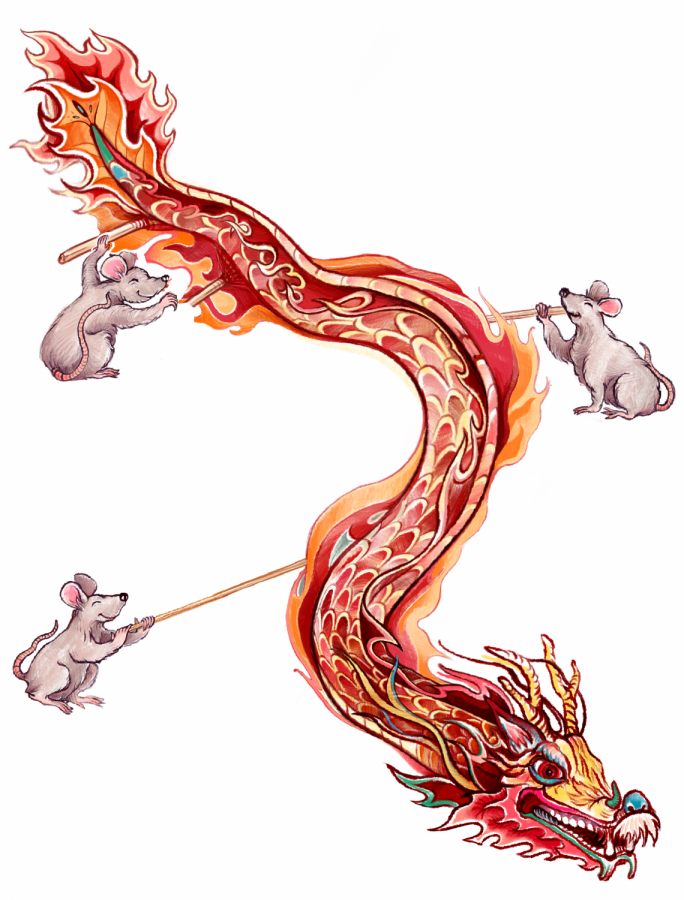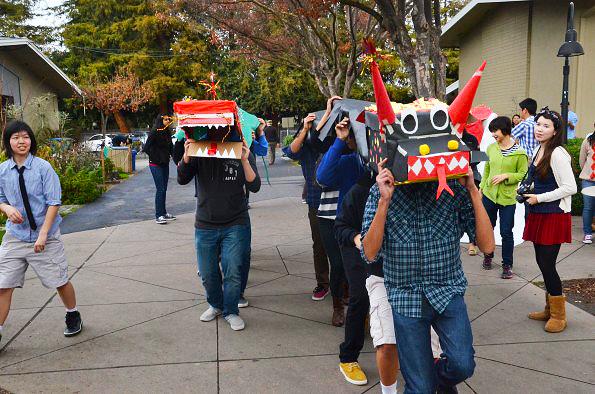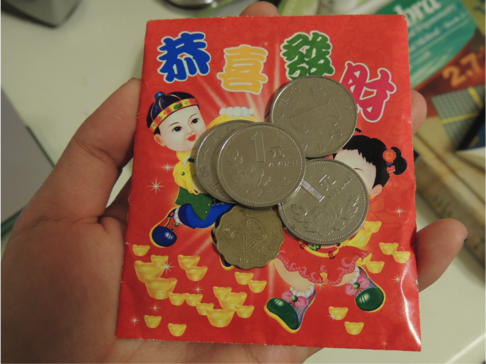Lanterns and rats, noodles and dragons: Lunar New Year’s history and traditions
Dragons symbolize wisdom, power and wealth and are believed to bring good luck to people. Dragon dancing is an ancient traditional dance that is said to scare away evil spirits.
March 9, 2020
Rats, oxen, tigers, rabbits, dragons, snakes, horses, goats, monkeys, roosters, dogs and pigs.
What do these animals have in common? They’re all Chinese zodiac signs, dedicated to mark the beginning of Chinese New Year. Also known as the Lunar New Year after the lunar calendar, this year’s celebration fell on Jan. 25, commencing the year of the rat. The lunar calendar is based on the monthly cycles of the Moon’s phases. Chinese New Year is celebrated not only in China, but also in Korea, Vietnam and in other Asian communities throughout the world. Although there are small discrepancies among the celebrations of different communities, they are generally quite similar.
“[My family celebrates Chinese New Year] because it’s the lunar new year, the coming of a new year, and of course, the Chinese have a lot of different traditions, like the zodiac calendar and the lunar calendar,” said Jessica Zhou (9), who celebrates the Chinese New Year with her family annually. “I just think it’s really cool how something so old still survives for so long.”
History
The exact date as of when the zodiac was essentially created is unknown, but they were officially identified during the Han Dynasty. Numerous myths were written to explain the creation of the zodiac signs and the traditions behind Lunar New Year.
It is said that the 12 animals of the zodiac signs were selected through a race. In order to win, the animals had to cross a river with a harsh current and reach the finish line on the shore. The cat and the rat, the worst swimmers but the most cunning, crossed the river by riding on the ox. In desperation to win, the rat pushed the cat off the ox, and finished the race in first. The order of the lunar calendar follows the outcome of the race, where the rat is the first animal to start the sequence, and the pig is the last. After the pig, the sequence starts over again.
“In general, [Chinese New Year] is the most important holiday in Chinese culture because it’s the renewal of the year. That was the time of year when debts were cancelled, you would get a haircut, get new clothes,” Dr. Shaun Jahshan, the Mandarin teacher, said. “For poor people it was the only time of year when they could do these things, and for wealthy people, it’s a time to come together and be with your family and also just to renew those social connections.”
Chinese New Year traces back to a monster named “Nian,” meaning “year” in Chinese. It dwells at the bottom of the sea and comes up once a year to feast on animals and humans. The villagers realized that loud noises and the color red were Nian’s kryptonite. This is why, on New Year’s Eve, families decorate their houses with red and firecrackers are sounded at midnight. People typically also wear new red clothing to celebrate.
Traditions
Lunar New Year is also a time when family members reunite and enjoy a day of festivities ranging from dragon dancing to firecrackers to hanging red lanterns. In Korea, the celebration lasts three days: the day of, before and after the new year. In Japan, every year at midnight on New Year’s Eve, Buddhist temples ring all over the country 108 times, a ceremony known as joya no kane. 108 is the number of human desires, which originates from Buddhist teachings, and the ritual is meant to drive away negative emotions from the past year.
“In the modern world, it’s the one time when many people have a vacation so they can go home and see their families because a lot of Chinese people work far from home,” Dr. Jahshan said. “They have to leave their kids at home, so sometimes it’s the only time of year they get to see their kids. They’re trying to get home in any way possible [since] it’s extremely important.”
Dragons symbolize wisdom, power and wealth and are believed to bring good luck to people. Dragon dancing is an ancient traditional dance that is said to scare away evil spirits. Dating back to the Han Dynasty, it was used in ceremonies to worship ancestors and pray for rain. The Chinese regard odd numbers as auspicious, so people often made a nine, 11 and 13-jointed dragon. The dragon body is woven in a round shape of thin bamboo strips and covered with a huge red cloth with dragon scales decorating it. The whole dragon is usually up to 30 meters in length, and people hold rods every one to two meters to raise the dragon segments.
Used to decorate homes and public places during the new year, lanterns have become a symbol of national pride in China. Historians believe that the Chinese first began making these traditional lanterns during the Eastern Han Dynasty. The original use of lanterns was primarily to provide a shaded light both indoors and outdoors.
In the Korean Lunar New Year, people will dress up in traditional outfits and perform seh bae, a ritual where Koreans bow to their elders.
“My nephews bow to me, and then I will give them allowance or wisdom. And now when I’m grown, I bow to my parents and uncles and so on,” said Jonathan Rim, a world history teacher who celebrates the Korean Lunar New Year. “I’ll give them cash—it’s saying thank you for raising me.”
Food
Food is also a prominent part of the celebration. From sticky rice pudding to dumplings, there’s a story behind every common place dish.
Fish represent an increase in prosperity and in Chinese, yu sounds like “surplus.” What fish should be chosen for the New Year dinner is based on propitious homophones. The head should be placed toward distinguished guests or elders, representing respect. Diners can enjoy the fish only after the one who faces the fish head eats first. The fish shouldn’t be moved or flipped, and the two people who face the head and tail of the fish should drink together.
Dumplings symbolize wealth because they look like Chinese silver ingots, which are boat-shaped. The Chinese believe that the more dumplings you eat during the New Year celebrations, the more money you can make in the New Year. Sweet rice balls, tang yuan in Chinese, represent family unity. The pronunciation and round shape of tangyuan are associated with reunion and being together.
Other Asian cultures have celebratory traditional foods they eat for the Lunar New Year as well. Thinly sliced rice cakes, duk gook, which are white, represent a clean start and a new beginning in Korea. O-sechi ryori, or New Year’s day feast, is celebrated in Japan, and it requires days of planning and preparation. Often, dishes like toshikoshi soba and mochi are served.
Last but not least, noodles symbolize longevity. Their length and uncut preparation are also representative of a healthy and long life. They are longer than normal noodles and uncut, either fried and served on a plate, or boiled and served in a bowl with their broth.
Chunjie Kuaile. Gong Hei Fat Choy. Gongxi Fa Cai. Xin Nian Kuai Le. Chuc Mung Nam Moi. Sehe Bokmanee Bateuseyo. Akemashite Omedetou Gozaimasu. Wishing you a prosperous and happy year — and beyond.


















![“[Building nerf blasters] became this outlet of creativity for me that hasn't been matched by anything else. The process [of] making a build complete to your desire is such a painstakingly difficult process, but I've had to learn from [the skills needed from] soldering to proper painting. There's so many different options for everything, if you think about it, it exists. The best part is [that] if it doesn't exist, you can build it yourself," Ishaan Parate said.](https://harkeraquila.com/wp-content/uploads/2022/08/DSC_8149-900x604.jpg)




![“When I came into high school, I was ready to be a follower. But DECA was a game changer for me. It helped me overcome my fear of public speaking, and it's played such a major role in who I've become today. To be able to successfully lead a chapter of 150 students, an officer team and be one of the upperclassmen I once really admired is something I'm [really] proud of,” Anvitha Tummala ('21) said.](https://harkeraquila.com/wp-content/uploads/2021/07/Screen-Shot-2021-07-25-at-9.50.05-AM-900x594.png)







![“I think getting up in the morning and having a sense of purpose [is exciting]. I think without a certain amount of drive, life is kind of obsolete and mundane, and I think having that every single day is what makes each day unique and kind of makes life exciting,” Neymika Jain (12) said.](https://harkeraquila.com/wp-content/uploads/2017/06/Screen-Shot-2017-06-03-at-4.54.16-PM.png)








![“My slogan is ‘slow feet, don’t eat, and I’m hungry.’ You need to run fast to get where you are–you aren't going to get those championships if you aren't fast,” Angel Cervantes (12) said. “I want to do well in school on my tests and in track and win championships for my team. I live by that, [and] I can do that anywhere: in the classroom or on the field.”](https://harkeraquila.com/wp-content/uploads/2018/06/DSC5146-900x601.jpg)
![“[Volleyball has] taught me how to fall correctly, and another thing it taught is that you don’t have to be the best at something to be good at it. If you just hit the ball in a smart way, then it still scores points and you’re good at it. You could be a background player and still make a much bigger impact on the team than you would think,” Anya Gert (’20) said.](https://harkeraquila.com/wp-content/uploads/2020/06/AnnaGert_JinTuan_HoHPhotoEdited-600x900.jpeg)

![“I'm not nearly there yet, but [my confidence has] definitely been getting better since I was pretty shy and timid coming into Harker my freshman year. I know that there's a lot of people that are really confident in what they do, and I really admire them. Everyone's so driven and that has really pushed me to kind of try to find my own place in high school and be more confident,” Alyssa Huang (’20) said.](https://harkeraquila.com/wp-content/uploads/2020/06/AlyssaHuang_EmilyChen_HoHPhoto-900x749.jpeg)












